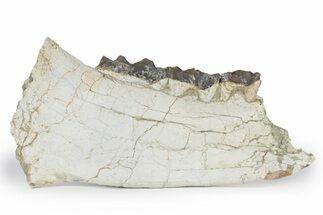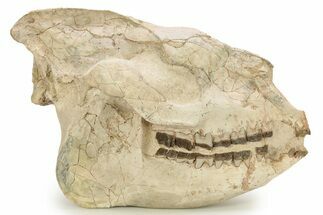This Specimen has been sold.
.53" Fossil Early Ungulate (Oxacron) Jaw - France
This is a .53" wide portion of the lower jaw (mandible) from the Miocene ungulate Oxacron courtoisii. The bone contains one well preserved tooth.
Oxacron was a genus of small herbivorous ungulates. They were in the artiodactyl order, related to modern camels, deer, and giraffes. In spite of this, Oxacron's small size and limb morphology suggests that it moved more like extant rabbits, hopping along at high speeds. However, based on trace fossils attributed to the Cainotheriid family to which Oxacron belongs, most scientists now believe that their locomotion was similar to modern ruminants. They were small generalist herbivores, likely feeding on anything leafy in their habitats.
The Artiodactyls are a group of mammals often called "even-toed" ungulates. They are called such because modern members of the group support their bodies on enhanced third and fourth digits (fingers), ending in hooves. Their first, second, and fifth digits are often reduced or nonexistent in modern species, however many extinct and fossil species retain five-toed feet. All artiodactyls, with the exception of whales and their ancestors, are herbivorous.
The Quercy Phosphorites Formation in France is world famous for its Eocene to Miocene faunas, especially those from the upper Eocene to lower Oligocene. The latter particularly helped to understand the ‘Grande Coupure’, a dramatic faunal turnover event that occurred in Europe during the Eocene-Oligocene transition. Fossils from the Quercy Phosphorites were excavated during the mid-19th century until the early 20th century from a series of sites that are no longer accessible. These fossils have subsequently dispersed between several research institutions, unfortunately losing some temporal and geographical information in the process. This material is part of an old collection we acquired that presumably was collected along with this material in the 19th or early 20th century. A recently published paper on the mammals of the Quercy Phosphorites can be found below.
The upper Eocene-Oligocene carnivorous mammals from the Quercy Phosphorites (France) housed in Belgian collections
The upper Eocene-Oligocene carnivorous mammals from the Quercy Phosphorites (France) housed in Belgian collections
SPECIES
Oxacron courtoisii
LOCATION
Lot (Formerly Quercy), France
FORMATION
Quercy Phosphorites Formation
SIZE
.53" Wide
CATEGORY
ITEM
#248695
We guarantee the authenticity of all of our specimens.
 Reviews
Reviews












